What are the Raccoon’s Mating Habits?

Raccoons are mostly found in forests, but they can adapt in other habitats such as urban areas and the marshlands. It is one of the common animals that can make their way into your attic. And more often than not, this happens after the raccoon mating season. That’s why homeowners should understand the mating habits of the raccoons to better protect the home from intrusions. This will also keep the raccoons protected.
When is the Mating Season?
Raccoon mating season occurs between the months of January and June. It takes around nine weeks or approximately 63 days after mating for the mother to give birth to the offspring. Raccoons can produce from one to seven raccoon kits, although the litter is typically composed of three to four babies.
The mating season begins in late winter. If the female raccoon doesn’t breed at this time, she will be in heat again in four months and can mate at that time. She will then give birth to babies later in the summer. Most baby raccoons are born in April to May.
Due to the prolonged mating season, baby raccoons will be born at any time from winter to early fall. During this time, the mother raccoon will build a den that will provide a safe and warm place for the babies. And one of their favorite spots is the attic.
Male Raccoon Mating Habits
The male of the species can breed with females in the first spring after they are born. However, most young males don’t participate during that time because of the presence of older males. When it is time to look for a mate, the male goes around one’s territory to look for females they can mate with. Then the mating happens in a centralized area where several raccoons get together to find a partner. The mating last for an hour and can be repeated with the same partner for a couple of nights. Non-dominant males also have a chance to mate if there are more females in the area. However, raccoons are not monogamous, and some females can mate with several males during the breeding season.
After mating with females, the male raccoon goes back to one’s den for the rest of the cold season. Raccoons don’t hibernate, but they can spend a long time inside their den without eating during winter. The male doesn’t stay with the females throughout the gestation period and doesn’t do anything when it comes to raising the babies.
Female Raccoon Mating Habits
The female raccoon is ready to mate when it is around 10 months old. After mating with the male, the female raccoon will return to its den and stay there for the rest of winter. After it gives birth, the mother raccoon spends most of the time looking for food. She will also nurse her babies in the same spot for the first eight weeks. Once the baby raccoons are around eight to nine weeks old, they are strong enough to travel with the mother.
Read the How to get rid of raccoons page for helpful information and to learn more about What are the Raccoon’s Mating Habits?

